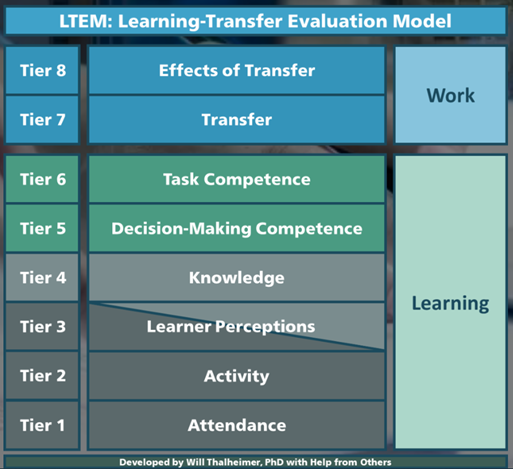Barriers to Evaluation: 4 Proven Models to Evaluate Your Learning and Development Initiatives
 Chloe Martin
·
5 minute read
Chloe Martin
·
5 minute read
The purpose of implementing learning and development initiatives is to develop your employees and create a positive and significant organisational impact, right?
So how do we know we’re achieving this if we fall at the evaluation stage?
We understand the link between learning and business impact can be a tricky one to evaluate.
However, we’ve listed 4 proven models to help you evaluate your learning and development initiatives across your department or team. Keep reading to find out more.
Why do we need to Evaluate Learning and Development Initiatives?
Evaluation is all about understanding what works well, what could be improved and why. There are heaps of benefits to evaluating your L&D initiatives, including…
- Gives employees a voice – allowing them to provide feedback to those providing or commissioning the training.
- Allows you to improve or develop your organisation’s learning culture
- Gives you (as an L&D professional) the opportunity to show organisational leaders the benefits of their L&D investments
Still need to conduct training but don't know where the skills gaps lie? We can help you.
What are the Common Barriers to Learning and Development Evaluation?
Whether you’re aiming to measure the ROI of your L&D initiatives or productivity increases throughout different departments, the act of evaluating these processes is tough for even the most experienced L&D professionals.
There can be many reasons that stop you from evaluating your learning and development initiatives effectively, these can include:
- HR capability
- Too many other organisational priorities
- The need to focus too heavily on results achieved over the positive impact
- Employees use multiple avenues for learning
The key is choosing the right evaluation method for your organisation and aims.
New to managing the training for employees? Read our blog post for everything you need to know about Learning and Development and a skills gap analysis.
Do you need specific analytics tools to evaluate effectively?
A common misconception that floats around the L&D community is that you need high-tech analytics tools to evaluate your learning and development initiatives effectively. Although they can be the most ‘accurate’ way to evaluate qualitatively, they don’t offer the chance for personal reflection among employees and an entirely individual learning journey.
We say it’s good to have a mix of both for the best results.
When Evaluating What Should We Look For?
Your evaluation of learning initiatives will most likely look at include mainly three things:
- Impact – demonstrates how learning programmes or initiatives have impacted performance – these may often include key financial or operational performance indicators
- Engagement – how engaged have employees or different teams been with the learning?
- Transferable – has the learning undertaken been transferred back into the workplace or employee roles? Have new skills and knowledge been used?
4 Models to Evaluate Your Learning and Development Initiatives
1. Anderson’s Value of Learning Model – great if you want to evaluate learning programmes throughout the organisation, rather than single learning initiatives
If you want to make sure your learning programmes are aligned with your organisational priorities, this is the model for your organisation. This model focuses on an evaluation of your learning strategy as a whole by using three main stages:
- Stage one: Think about your current alignment against organisational priorities. Is the training in line with organisational goals?
- Stage two: Focus on assessing and evaluating the results of training – focusing on key measures such as ROI, benchmark goals and capacity
- Stage three: Establish the most effective and relevant approaches for your organisation
Do your L&D initiatives improve your employee retention? If not, here are 5 strategies you can implement within the public sector.
2. Kirkpatrick Model - most popular for a wide variety of organisations
The Kirkpatrick model is said to be the most popular and widely used evaluation model out there. It consists of four levels which represent measures of the effectiveness of a training programme or initiative. These four levels include:
- Reaction – Reaction to the learning initiative. Ask questions to employees like: Did you feel the training was worth your time, what do you plan to apply to your role or which activity did you find most engaging? This can be used as an ‘early warning’ of a programme that might not be working.
- Learning – information absorbed, or facts learnt. Also, take time to focus on what they didn’t learn.
- Behaviour – how they will apply the training. Encourage positive changes in behaviour for employees to implement the new knowledge.
- Results – Identify which outcomes and final results are linked to the training and then come up with an effective way to measure these outcomes in long term. This is the most costly and time-consuming part.
With this model, it’s important to note that it does have its limitations. For example, it fails to establish organisational aims and it does not take ROI into account.
3. Thalheimer’s Learning Transfer Evaluation Model (LTEM) – alternative to Kirkpatrick’s Model
Want to evaluate your current evaluation methods before you decide on a new evaluation path to take? As an alternative to Kirkpatrick’s four-level model, LTEM is a thorough way to help organisations and L&D professionals to determine the effectiveness of their current evaluation methods.
This model is divided into 8 different tiers that are colour-coded in a traffic light system. Here are the first four tiers to get you started:
- Attendance – the learner takes part in and completes the activity
- Activity – the learner takes part in the learning activity. This section is broken down into three sub-levels: interest, participation and attention
- Learner perceptions – the learner shares their perspectives on the activity via ‘*happy sheets’, surveys or informal feedback
- Knowledge – the learner is tested on how well they can recall the knowledge and facts from the learning initiative – this could be immediately after or a few days later.
This model is the best way to identify what level you are currently evaluating your L&D initiatives at and advance to the next level for greater insights.
*A ‘happy sheet’ is used immediately at the end of the training to gain feedback from a programme or initiative. Although this method allows employees to give an immediate reaction, it may be influenced by the setting in which it is completed or to who it will be returned to. To get the most honest feedback from employees, give them the option to complete a form anonymously online.

Is your learning and development strategy futureproof? Here’s four simple steps to follow so you can ensure yours is.
4. Brinkerhoff’s Success Case Method – cost-effective approach
This model understands that some learning programmes will be a success and others will fail, but more often than not, they will fall somewhere in the middle. When analysing any learning programme or initiative, there will always be two things to focus on: the learners who performed/scored well and those who the programme did not work for.
This method is all about identifying and studying the most and least successful cases within your learning initiatives. While this method would be best paired with another method to provide a full picture, this is a cost-effective and insightful way to learn lessons, understand areas of improvement, shout about successes and understand the value of your initiatives.
NOTE: The Brinkerhoff method isn’t just for learning and development analysis either. It can also be used to analyse a change in your organisation – such as the implementation of a new process. This is what makes learning and understanding this method important and worthwhile.
How do we Choose the Right Evaluation Model?
It’s easy to start panicking about choosing the right evaluation model for your organisation, but it depends on what you’re looking to achieve through your learning and development initiatives. It’s important that L&D professionals take a customised approach to learning evaluation and aim to experiment to find the one that suits you best.
No matter which model you choose, you’re on the right track to presenting stronger evidence to organisational stakeholders or leaders to show this is the right step forward to reach organisational or strategic aims.
Want More Learning and Development Tips and Expert advice?
Download our free Learning and Development handbook that’s jampacked full of strategies that will help you support, retain and grow a varied workforce and much more. Simply click the button below to download your copy.
2+ years in SEO and content marketing. Striving to help public sector professionals develop their skills and learn something new through high-quality content.






%20ompressed.jpg)
-Dec-20-2023-11-37-00-4108-AM.jpg)
